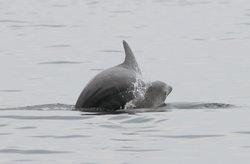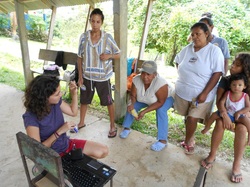
Hello all, this is Ashley Sitar updating you from Bocas del Toro. I’m now 8 weeks into my study and things are going well. I’ve gathered lots of data and already seeing that there may be big differences in the behavior of dolphins with and without tour boats. I’ve collected questionnaires from tourists, local residents and stakeholders, and one thing has become clear, there is a huge amount of local support for dolphin and marine conservation.
As for our community of Bocas dolphins, I have seen the group with dolphin Bity who seem to be the babysitter and helper to new dolphin mom, and her baby (Bocas newest addition) in Dolphin Bay. They were first spotted in Loma Partida last month, which is hypothesized to have been this group's nursery ground for the baby. But now they have been spotted twice foraging in Dolphin Bay where the occurrence of whale watching boats presence is much higher. The baby is definitely learning how to become more independent but when boats are around mom and baby stick close together side by side.


